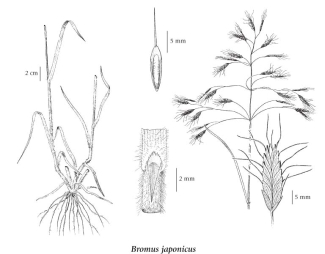Bromus japonicus Thunb.
Japanese brome
Poaceae (Grass family)
Introduction to Vascular Plants
Japanese brome
Poaceae (Grass family)
Introduction to Vascular Plants
Species Information
General:
Annual grass from fibrous roots; stems 20-50 (70) cm tall.
Leaves:
Sheaths densely hairy, the hairs long and angled downwards (at least the lower ones); blades 1.5-3 (4) mm wide, flat, usually soft-hairy; ear-shaped lobes lacking at the leaf-bases; ligules hairy, jagged with fine hairs, 0.5-1.5 mm long.
Flowers:
Inflorescence an open, diffuse panicle, 7-15 (rarely 20) cm long, the branches slender, spreading to drooping and usually more or less wavy; spikelets 7- to 12-flowered, slightly compressed, smooth or more or less rough, 2-4 cm long, the stalks mostly longer than the spikelets; florets mostly small, closed, self-fertilizing; lower glumes lanceolate, 3-nerved, (3.5) 4-6 mm long, the upper ones lanceolate, 5-nerved, 5.5-8 mm long; lemmas somewhat leathery, broadly lanceolate, nearly circular in cross-section, tapered, rough, faintly 9-nerved, somewhat compressed, rounded on the backs, 8-10 mm long, up to 4 mm wide, the tips blunt and rounded and merely shallowly notched but readily splitting to the awns, the awns inserted 1-2.5 mm below the tips of the lemmas, usually somewhat twisted and abruptly bent at maturity, broadly spreading, flattened at the bases, 8-12 (15) mm long; paleas 1.5-3 (4) mm shorter than the lemmas; anthers included within the lemmas, about 1 mm long. vol7_3
Illustration

If more than one illustration is available for a species (e.g., separate illustrations were provided for two subspecies) then links to the separate images will be provided below. Note that individual subspecies or varietal illustrations are not always available.
Illustration Source: The Illustrated Flora of British Columbia
Ecology
Ecological Framework for Bromus japonicus
The table below shows the species-specific information calculated from
original data (BEC database) provided by the BC Ministry of Forests and Range.
(Updated August, 2013)
The table below shows the species-specific information calculated from
original data (BEC database) provided by the BC Ministry of Forests and Range.
(Updated August, 2013)
| Site Information |
Value / Class |
||
|
Avg |
Min |
Max |
|
| Elevation
(metres) |
686 | 385 | 1480 |
| Slope
Gradient (%) |
33 | 0 | 80 |
|
Aspect (degrees) |
175 | 0 | 346 |
| Soil
Moisture Regime (SMR) [0 - very xeric; 4 - mesic; 8 - hydric] |
2 | 0 | 5 |
| Modal
Nutrient Regime
Class |
C | ||
| #
of field plots species was recorded in: |
62 | ||
| Modal
BEC Zone Class |
IDF | ||
|
All BEC Zones (# of stations/zone) species was recorded in |
BG(3), ICH(1), IDF(49), MS(1), PP(7) | ||
|
Source:
Klinkenberg 2013
|
|||